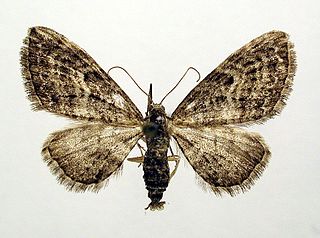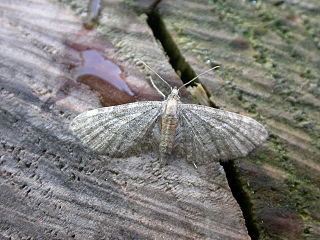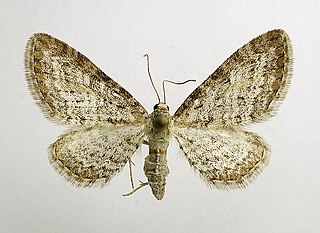Related Research Articles

Eupithecia is the largest genus of moths of the family Geometridae, and the namesake and type genus of tribe Eupitheciini. Species in the genus are, like those of other genera in the tribe, commonly known as pugs. The genus is highly speciose, with over 1400 species, and members of the genus are present in most of the world with exception of Australasia. Roughly a quarter of described Eupithecia species occur in the Neotropical realm, where they have an especially high species diversity in the montane rain forests of the Andes. The genus includes a few agricultural pest species, such as the currant pug moth, Eupithecia assimilata, which is a pest on hops, and the cloaked pug moth, Eupithecia abietaria, which is a cone pest in spruce seed orchards.

The juniper pug or juniper looper is a moth of the family Geometridae. The species was first described by Michael Denis and Ignaz Schiffermüller in 1775. It is found throughout the Palearctic and in the Nearctic.

The larch pug is a moth of the family Geometridae. The species can be found in Europe, the Ural Mountains, West and Central Siberia, the Altai Mountains, Transbaikalia, Yakutia, the Far East, Mongolia, Korea, Japan and in North America, from Yukon and Newfoundland to New York and Arizona.

Eupithecia haworthiata, or Haworth's pug, is a moth of the family Geometridae. The species was first described by Henry Doubleday in 1856. It can be found in western, south and central Europe, Asia Minor, the Caucasus and east across the Palearctic to Amur. It occurs in the Alps up to 1800 meters, in the Apennines up to 1400 metres and in the Balkan mountains up to 1500 m above sea level.

Eupithecia simpliciata, the plain pug, is a moth of the family Geometridae. It is found in the Palearctic realm, from western Europe to north-western China (Xinjiang). The species primarily colonizes wastelands, rubble and abandoned vineyards, and in Asia also salt steppes. In the Alps, the range of altitude extends up to 1200 metres.

Eupithecia satyrata, the satyr pug, is a species of moth of the family Geometridae. It was described by Jacob Hübner in 1813. It is found from Ireland, through northern and central Europe east to all of Russia and central Asia and western Siberia to Tibet. It is also present in North Africa and North America.

Eupithecia actaeata is a Eurasian species of moth of the family Geometridae.

Eupithecia subumbrata, the shaded pug, is a moth of the family Geometridae. The species was first described by Michael Denis and Ignaz Schiffermüller in 1775. It is found from Mongolia and the Altai Mountains through Siberia, central Asia, Asia Minor and Russia to western Europe and from central Scandinavia to the Mediterranean region.

Eupithecia quadripunctata is a moth in the family Geometridae. It is found in India, Pakistan, Nepal, Russia, China, Taiwan, Korea, Japan and northern Thailand.
Eupithecia rajata is a moth in the family Geometridae. It is found from the southern Himalaya to south-western China (Yunnan), Myanmar and Thailand.
Eupithecia invicta is a moth in the family Geometridae. It is found in Nepal, India, China, Vietnam and Thailand.
Eupithecia maculosa is a moth in the family Geometridae first described by András Mátyás Vojnits in 1891. It is found in Nepal, north-eastern India and Pakistan.
Eupithecia lineosa is a moth in the family Geometridae. It is found in India (Kashmir), Nepal and Pakistan.
Eupithecia subrubescens is a moth in the family Geometridae. It is found in India, Pakistan (Kohistan), Jammu & Kashmir and Nepal.
Eupithecia impavida is a moth in the family Geometridae. It is widespread, ranging from the western Himalayas through southern and central China to Japan.

Eupithecia silenicolata is a moth in the family Geometridae. It is found from southern Europe and Morocco to western Asia, Iran and Pakistan. In the north, the range extends to southern Switzerland, Austria and northern Italy.
Eupithecia tenuisquama is a moth in the family Geometridae. It is a widespread species, ranging from the Himalaya to Japan.
Eupithecia mesodeicta is a moth in the family Geometridae. It is found in Pakistan and India.
Eupithecia acutangula is a moth of the family Geometridae first described by George Hampson in 1895. It is found in Pakistan and India.
Eupithecia acolpodes is a moth in the family Geometridae. It is found in India and Pakistan. Vladimir Mironov and Anthony Galsworthy place the species as part of the sinuosaria species group.
References
- ↑ Yu, Dicky Sick Ki (1997–2012). "Eupithecia particeps Vojnits 1988". Home of Ichneumonoidea. Taxapad. Archived from the original on March 24, 2016.
- ↑ Mironov, V.G. ,A.C. Galsworthy & U. Ratzel, 2008, A survey of the Eupithecia fauna (Lepidoptera: Geometridae) of the Western Himalayas: Part 2, Transactions of the Lepidopterological Society of Japan59 (2): 117-143.